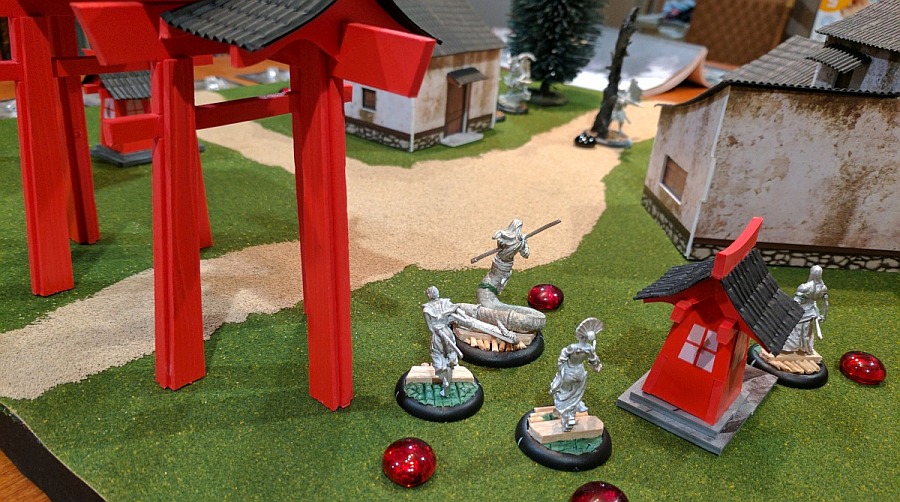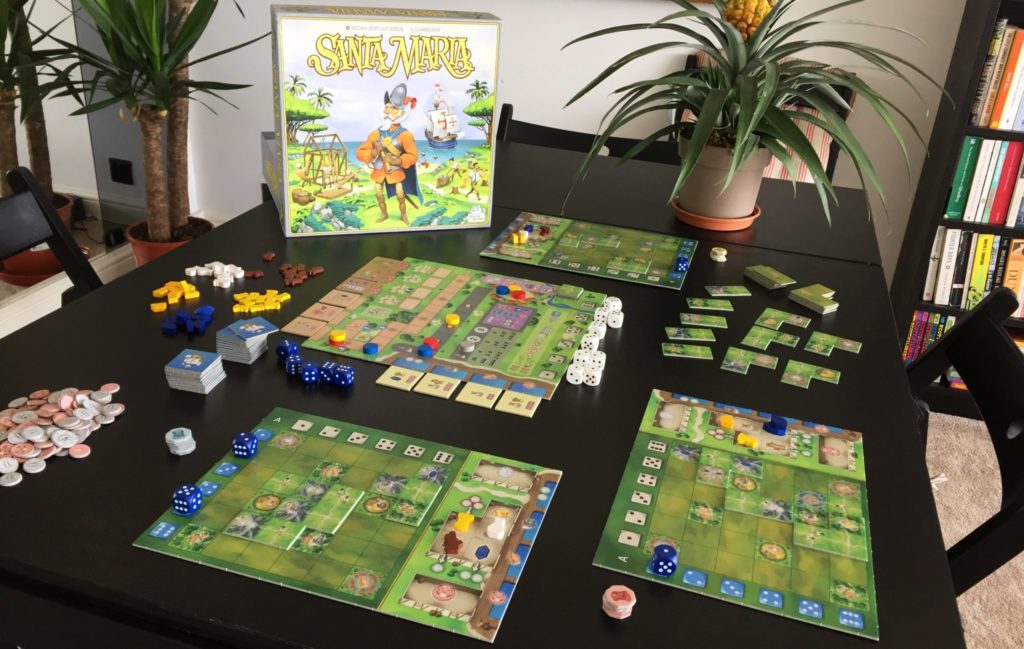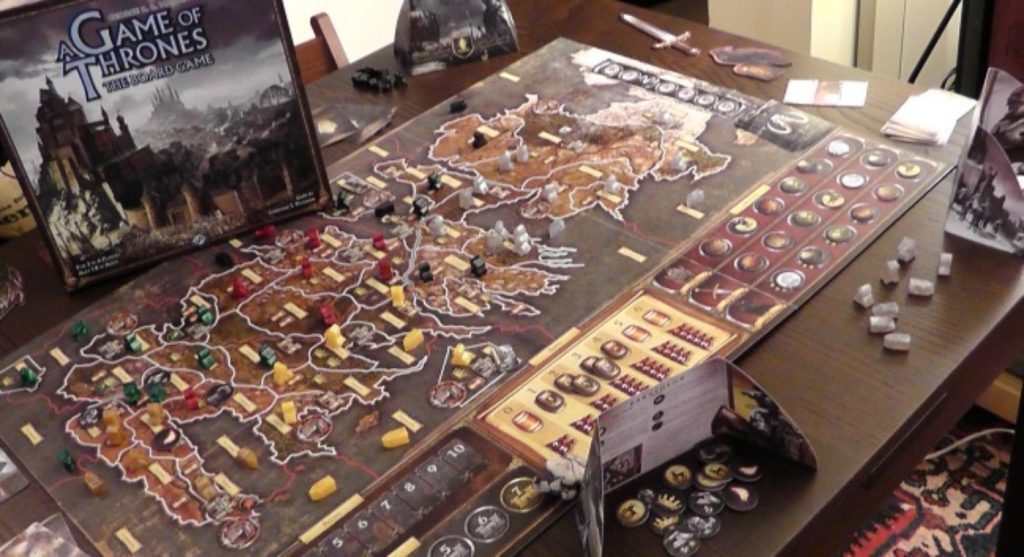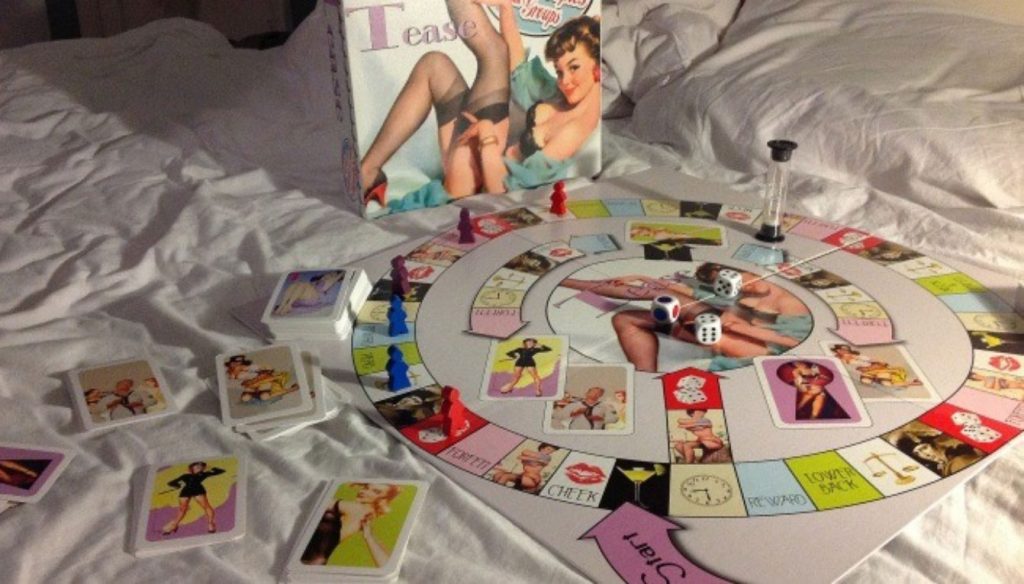Eric: I’m standing here, what feels like a katana in my chest, the bodies of my soldiers piled around me. I’m standing here defeated and absolutely delighted, a big grin on my face, trying to figure out what it’s doing there.
That was the end of my second play of Bushido by GCT Games – the actual impaling being only metaphorical, if you’re the queasy sort, but the defeat and delight being real. From my first encounter, what intrigued me about Bushido was that I found it immensely pleasurable even when I lost horribly. Let me try to explain why.
If the name and picture don’t make it apparent, Bushido is a tabletop skirmish game set in a world inspired by Japanese folklore, or at least a western, Tolkein-filtered riff on Japanese folklore. Elves and Dwarves are replaced by Tengu and Oni, the heroes include snake-people and warrior pandas, and the outfits look like the result of a raid on a Kurosawa film’s prop closet. All in the best possible way.
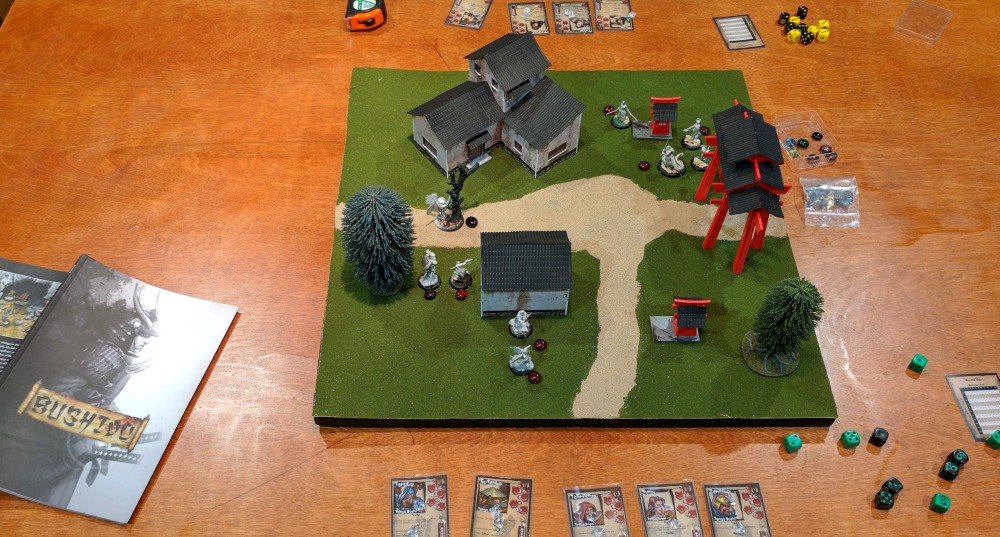
Ever since I started reviewing tabletop miniatures games for SU&SD, there’s been this holy grail of a game I’ve been searching for. The perfect miniatures game to start a board gamer’s dalliance with tabletop miniatures. Something affordable and efficient, that transpires as happily as a slapstick movie.
There are games that have gotten close. Infinity is brilliant, but heinously complicated. Malifaux is close as well, despite my aesthetic reservations, but the way it approaches building a crew means that a big collection of models is a big advantage. X-Wing and Armada are both fantastic, but their pre-assembled, pre-painted ships prepare no-one for the savage reality of glueing your fingers together.
Bushido, by GCT Games, comes closer than anything else I’ve reviewed.
The miniatures are what first piqued my interest. After years of painting endless variations on the “muscular man with a big sword” and “muscular ork with an even bigger sword,” it’s refreshing to work on bird-people, gorillas and silky kimonos. The sculpts have fine details and poses that convey action, and… Look, I like them a lot. You have to assemble them yourselves, but that’s only a small hiccup.
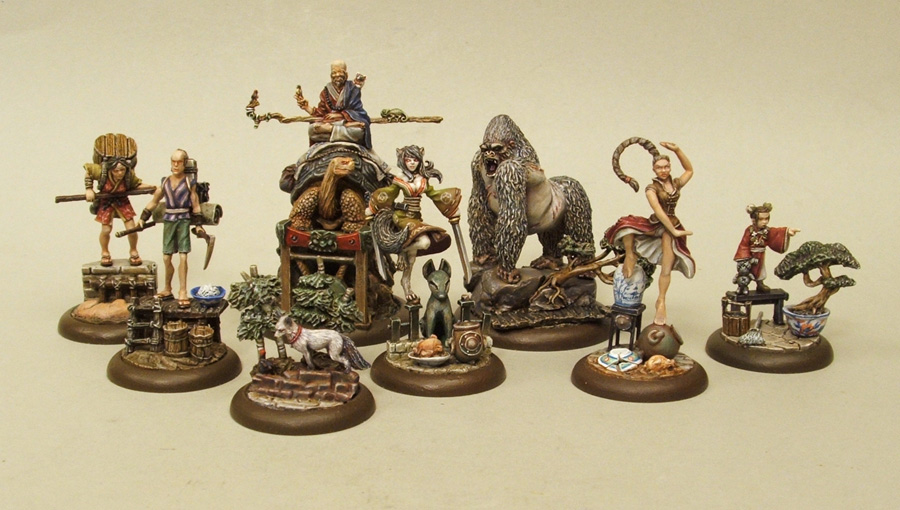
The miniatures first got me interested, but they aren’t what account for my love of the game. Beauty is cheap in the modern world. Anyone can have a bevy of (pewter-and-plastic) models hanging around (on their shelf) if they’re willing to shell out enough money.
And besides, unlike some games, Bushido isn’t about big spectacles. It only uses 4-8 models per side, which is great for beginners. Even better for those starting, this scale translates to the playing space. Bushido uses a 2-foot-square board, much smaller than almost any other tabletop minis game on the market. You don’t need a massive amount of terrain and space to play. The small table also solves one of the perpetual frustrations of miniatures rules – the boring opening moves. In order to balance guns and melee combat, many games force you to wait 1-2 turns before anything interesting really happens. Not so here.
All of which is great, but again, that’s merely context. I was impressed by the size of Bushido, as sleek and deadly as a wakizashi. But the joy I take in the game, which plays out in a vicious, captivating flurry.
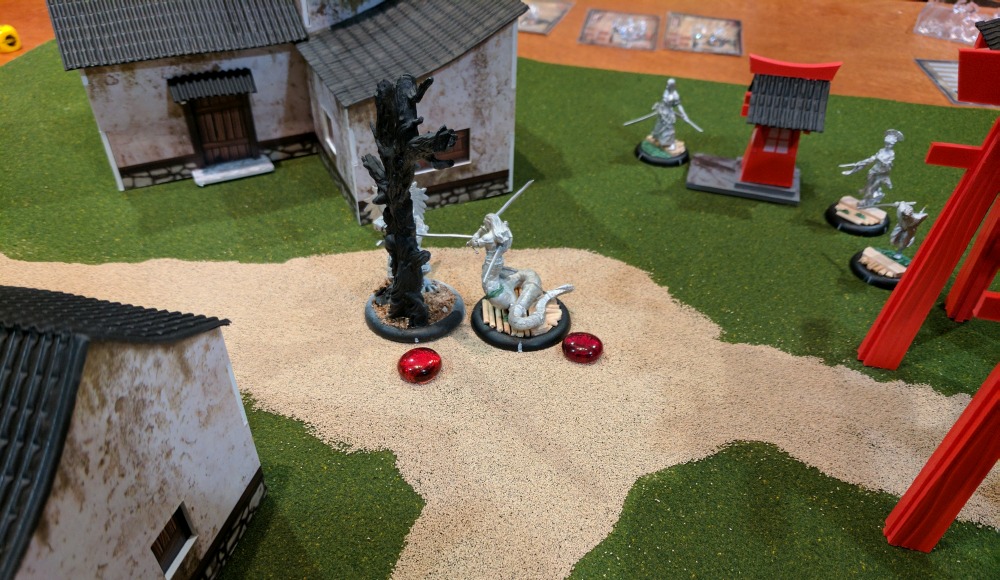
Bushido uses alternating activations (I move a model, you move a model), but with a twist. Each model has three “conditions” – Rested, Tired, and Exhausted. You can activate a model, even for a second time, as long as it isn’t exhausted. You can even use it twice in a row. But your opponent gets to do something in between.
Many miniatures games consist of one-sided splurges. Your whole army grinds forward, and your opponent can only watch and pray. Alternating activations start to solve this wallowing turn sequence, as we mentioned in our review of Malifaux. But layering the fatigue system on top, it’s even better. It’s like you only get half an activation at a time.
Which is especially stress-inducing because your opponent can mess with all that. When I attack you in melee, your model fights back. But that also fatigues you, which means I can rob you of precious half-turns simply by attacking first. If I do it repeatedly, I might prevent you from activating a model at all.
Bushido is about darting tempo and agonizing response. Let’s say I move up and strike. We are now both tired, but you are also confronted with a choice: do you attack back or do something else, knowing that I might choose to attack again on my next activation and you’d have lost your chance with that model entirely? If you want to keep me from dictating where we focus, you’ll have to allow certain models to be pummelled.
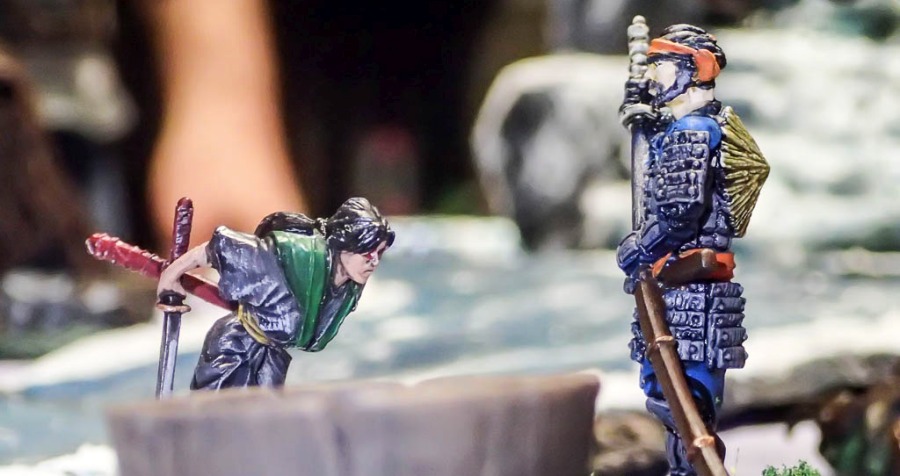
Photo courtesy of Chicago Skirmish Wargames.
You’re starting to see the outline of things now, an army slowly appearing from the bank of fog. But there’s more – we also need to talk about how combat itself works. In melee combat, both participants have a pool of dice, and before the fight starts, they secretly divide those dice into attack and defense. The active player usually attacks first, but assuming the defender survives, they can then strike back.
This is fantastic, and unique in my experience. It simulates the duels Bushido means to portray. There is a calculation to each fight, a knowledge that risks can pay off big or come back to bite you. Do you want to go all in on attack, hoping you kill your opponent before they strike back, or make a more modest attack and save some dice to defend? If you’re defending, do you just want to try to survive, or do you make a play for a brutal counter-strike? Simply revealing your dice pools can result in laughter and groans at the table.
There are other clever systems as well – ki tokens which models accumulate over time and which can be spent to boost some rolls or trigger special abilities. An interesting dice pool system. A long list of different abilities and synergies, interesting scenarios, lots of tasty little details. And I could go on parsing the engine, but that isn’t the point.
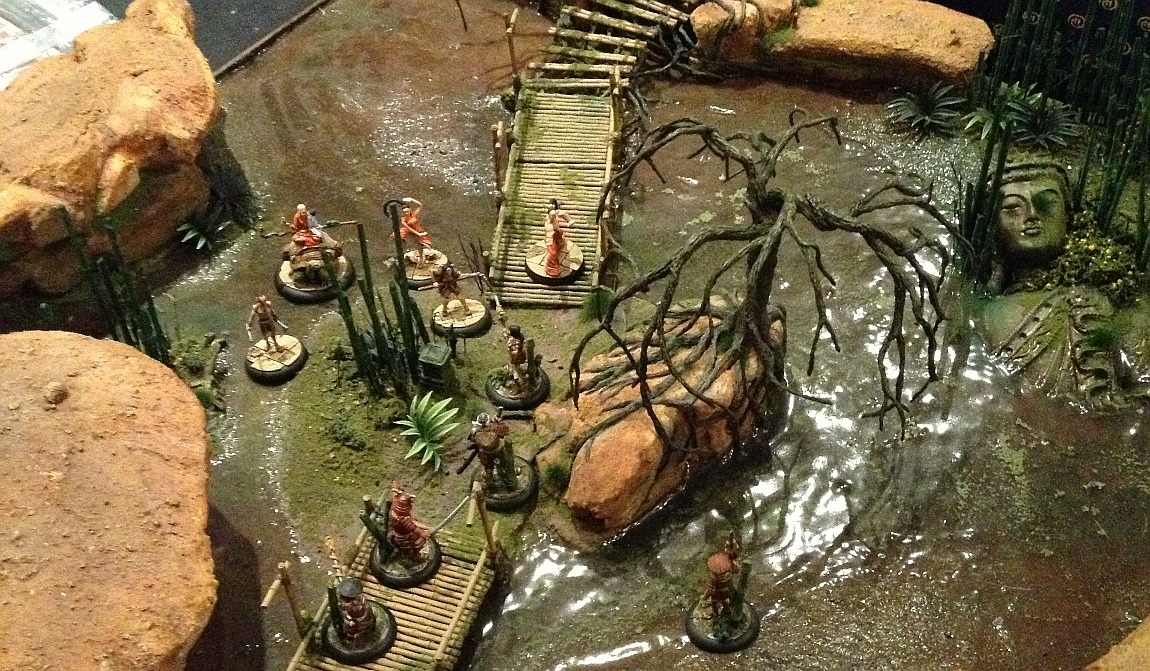
To see the point, let me instead describe to you that turn in my second game that left me horribly undone. See, I had a plan. I had it all sorted out, a series of chess-like maneuvers to put my opponent on their back foot. I only needed two things to happen: I needed one model to get both its activations, and I needed to kill an enemy model and have my model in that fight survive.
Second goal first. I went in to attack. Thus far, my opponent had been predictably defensive. But unexpectedly, this time they hadn’t allocated all their dice to defense. They’d put all but one into a counterattack, recognizing the threat and deciding to gamble on a big win.
Which they of course won, and now my oh-so-important warrior was dead. Alright, I think, this is still salvageable. But then my opponent moves up one of his models and attacks that other model, the one I needed to activate twice, tiring it and leaving me undone. At which point my entire turn shifts from the perfect offense to an (unsuccessful) attempt to just survive.
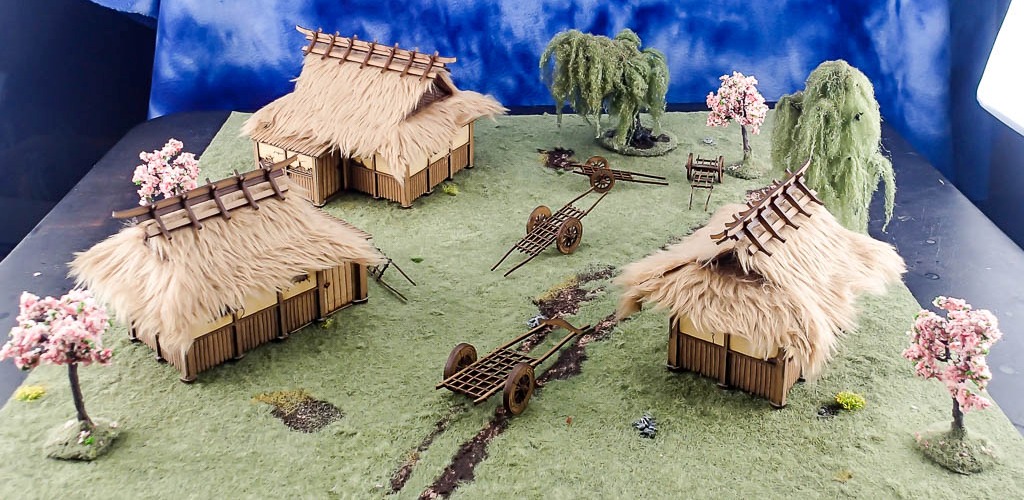
Photo courtesy of Chicago Skirmish Wargames.
Here’s what made all of that so pleasurable. One of the conceits of every samurai movie is that, before swords are even drawn, there is this long stare. Two warriors face each other as human beings, each seeking to control their emotions and know the thoughts of their enemy.
That is what happened on that brutal turn. At each step I would pause and look not at the models and terrain but at my opponent across the table. I would stare at them and try to guess what they were thinking. The game was just an extension of our ability to understand and predict each other, and I lost because my predictions were wrong.
Which is not at all common in miniatures games. Often, they rely only on constrained possibilities. When I’m playing Warmachine, I’m not trying to get into my opponent’s head. I simply measure the threat range of the giant robot and know that, if I don’t want it to hit me, I’ll stand outside of that range. As wonderful as Infinity is, with the exception of a select few cases, my reactions are predetermined. Will I shoot at my opponent or try to dodge them? The answer usually lies not in psychology or cunning but in my model’s stats. We’re playing the game first and your opponent only secondarily.
There is still a lot of game in Bushido, don’t get me wrong. And there are flaws, including some I haven’t really gone into – I don’t love the arcane damage table, which feels like a relic of an earlier age of game. It also has a long list of special rules for lots of models which you frequently have to look up in the rulebook, making your team of vigorous warriors seem just a little bit bloated, as if they were fighting 5 minutes after a heavy meal.
But what’s felt so refreshing about Bushido is that, at every point where it can, it introduces the opposing player back into the mix. The difficulty of an attack, the tempo of a turn, what models can still activate – these are all suddenly variables my enemy can influence. Which makes us constantly engaged with each other, cursing and laughing with the person across the table. It is, perhaps more than any other miniatures game, something you play with friends.
If it’s not obvious, Bushido comes highly recommended by me. It might not satisfy my never-ending quest for the perfect first miniatures game, but it delivers something almost better than perfection. It delivers humanity.
And also half-snake, half-girl-out-of-street-fighter warriors, old dudes riding giant turtles, fox ninjas and men smoking ghosts out of pipes. Those things are all important too.

